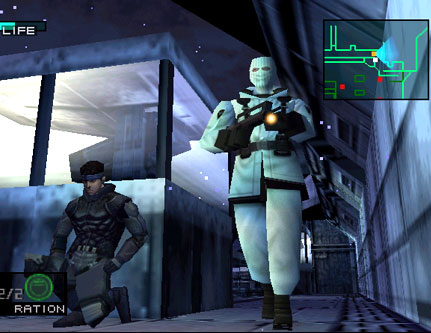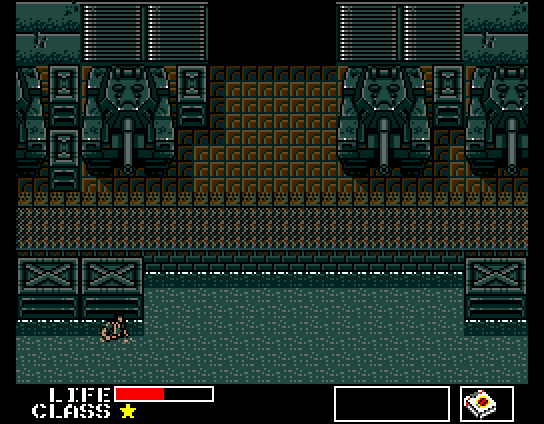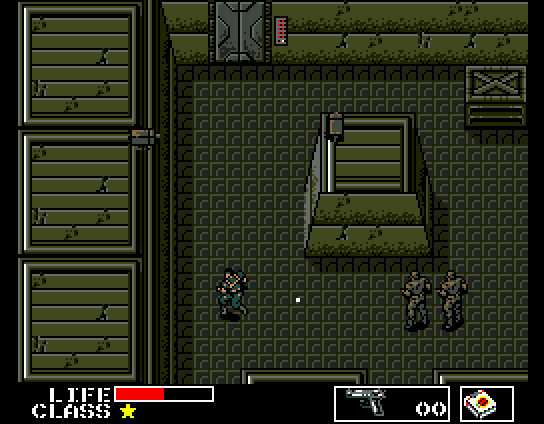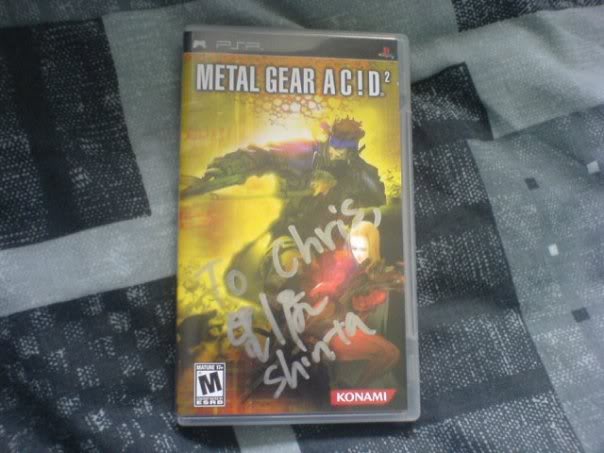This post has not been edited by the GamesBeat staff. Opinions by GamesBeat community writers do not necessarily reflect those of the staff.

Any time it snows, I always utilize my time off from school or work well: I replay Metal Gear Solid. Wrapped in a warm blanket, with a mug of coffee or hot chocolate by my side, I begin Solid Snake’s first PlayStation adventure. Set in Shadow Moses, an Alaskan nuclear-warhead disposal building that’s currently the base of operation for a rebellious special forces unit named FOXHOUND and genetically enhanced “Genome Soldiers.” Snake has to infiltrate the site, locate and rescue several hostages, and determine whether or not the terrorists have the ability to launch a nuclear weapon.
When I first read about the game in Computer and Video Games magazine as a kid, it sounded like the ultimate spy flick in game form. It's what eventually pushed me over my Nintendo 64 fanboyism and into the CD-based realm of the PlayStation, a system I’d previously (and unfairly) dismissed as having rather poor titles.
What happened after that constituted a large chunk of my teenage life. Following the release of Metal Gear Solid 2: Sons of Liberty, I launched Planet-MGS.com (later MetalGearSource.com), a humble fan site that I put together in my spare time to express my love for the series.
Six months later, just before Metal Gear Solid 3: Snake Eater’s first E3 reveal, it had transformed into a monster well beyond anything I’d planned: thousands of members and ad revenue that not only paid for the site’s upkeep, but also left me with a modest amount of pocket money. I was running the world’s largest Metal Gear site.
The banner from the site back in 2005 (about the only thing
I can produce from archives), created by Mike Carette.
This had profound effects on my personal and gaming lives. When I should’ve been studying for tests, I was dissecting the latest MGS3 trailer. I also missed most of the major game releases that weren’t Metal Gear Solid, instead spending most of my cash on the site or on rare MGS-related goodies and collectibles.
I amassed a very sizable collection, some of it bought, other items gifts from various staff at Konami and Kojima Productions. Most of it has been sold on since I gave up running the site to focus on school, but I’ve held on to the essentials, planning one day to go back over them and document the series from a hardcore Metal Gear fan’s perspective.
A copy of Metal Gear AC!D 2 signed by the game’s director, Shinta Nojiri.
Now's that time. I want to go over the entire series, game by game, pixel by pixel, and give gamers a perspective on a franchise that enjoys much critical acclaim but not the unconditional love of its most hardcore fans. Because of that, this article (and all future articles in this retrospective) will contain major plot spoilers for the series. If you haven’t played the games I’m talking about and don’t want a running commentary of the plot, it’s probably best to play them before reading this.
Metal Gear (MSX2)
It all started in 1987, the year I was born. Konami assigned Hideo Kojima to work on Metal Gear, then an action game for the MSX2 computer system. The story goes that hardware limitations hindered the gameplay. Under Kojima's direction, the focus shifted from shooting to stealth, inspired by one of his favorite movies, The Great Escape.
What ended up on store shelves was the beginning of the Metal Gear franchise, and while it’s fair to say that the series didn’t become a runaway success until Metal Gear Solid, looking back on the original shines light on the history of the series and, quite frankly, demonstrates how much of the gameplay from the PlayStation classic was lifted from the original.

The game opens with Solid Snake swimming into the enemy fortress, Outer Heaven, carrying only his cigarettes and a radio transceiver. Using radio frequencies, Snake can contact Big Boss, his commanding officer, for support throughout the mission, alongside three resistance members — Schneider, Diane, and Jennifer — each of whom provide information on different aspects of the game world, such as the weaknesses of certain bosses, the layout of the fortress, and weapon and item information. Radio frequencies can’t be saved due to hardware limitations, so remembering each one (or simply writing them down on paper) is vital to progress.
Snake’s mission is simple: Infiltrate the base, find the prisoner (fellow FOXHOUND member Gray Fox in this instance), and get as much information about the Outer Heaven terrorists as possible. After you’ve spoken to the Fox, you find out that the terrorists have a weapon of immense power: Metal Gear, a bipedal tank capable of launching nuclear attacks from any terrain. Your mission then changes to one of sabotage. You’re to destroy the Metal Gear by any means possible, and the only man who knows its weak spot is Dr. Pettrovich Madnar, its designer.
Is this starting to sound strangely familiar to you?
The mysterious legendary mercenary who founded Outer Heaven is backed up by a team of bosses with their own unique abilities: Shoot Gunner, the prison guard with a riot shotgun; Machine Gun Kid, armed with, you guessed it, a machine gun; Fire Trooper, a flame-throwing ex-GSG 9 soldier; Coward Duck, who hides behind hostages and uses a boomerang; and the Arnolds, a pair of androids designed by Dr. Pettrovich. Complementing these bosses are also a tank, a bulldozer, and a helicopter. And even back then, Kojima had a love for plot twists. Near the end of the game your commanding officer, Big Boss, is revealed to be the mysterious mercenary and mastermind behind the uprising at Outer Heaven.
Like the later 3D iteration, Metal Gear employed a dark, murky atmosphere, utilizing the MSX2’s limited colors in the most effective way possible. Looking back on it, you can see the kind of tone Kojima wanted to set, and anyone playing it at the time would no doubt fall right into the cinematic role Kojima intended, using their imagination to fill the gaps that the hardware limitations created.
Also like the later Metal Gear Solid games, the game never rewards you for killing, which reflects Hideo Kojima’s anti-war opinions. The range of your weapons is intentionally limited to encourage stealthy gameplay. You can’t acquire a silencer until you’ve become well accustomed to sneaking past enemies and taking them out stealthily.

To say the game is a masterpiece would be pushing it by today’s standards, but looking back on it as a product of its time, where the only games that attempted deeper plots were text-driven or point-and-click adventures, Metal Gear was well ahead of its time. It came from an age where an action game’s plot was either nonexistent or given a few lines in the instruction manual. It is, in many respects, the father of narrative-driven action gaming.
That said, Metal Gear has its problems. The hardware limitations led to a glitch whereby items respawn when you use the transceiver, meaning you can stock up on ammunition and rations early on. This is in part mitigated by the game’s ranking system, which limits the amount you of items can carry early on and rewards you with more storage for rescuing POWs trapped around the base. These POWs also conveniently act as the game’s exposition, revealing where your next objective is.
The action, especially against bosses, is marred by poor gunplay. The unfortunate trade-off of stealth-based gameplay is difficult bosses, who can nevertheless be easily exploited with remote-controlled missiles navigated from convenient safe points in boss arenas.
Equally frustrating is the amount of guesswork involved. Many doors of the game are locked, and an arbitrarily silly system of card-locked doors often means switching between cards 1 to 5 to unlock different doors. Card 5, for example, will not unlock the lower-ranked Card 1 doors, and with nothing on the doors to indicate which card to use, opening them often requires pausing to cycle through each card in your possession and trying them until you have the right one.
Similarly, figuring out which walls can be blown up can only be arrived at by accident, with no way of knowing which wall can be destroyed besides punching them until the sound is different. Just before this segment, rather absurdly, you have to punch through the prison wall of Gray Fox’s prison, which feels like a cheap way of escaping jail.

The presentation of the plot twist is also rather ham-fisted and awkward, with Big Boss continually sending you down obvious traps and awkward pathways in the run-up to his reveal as the bad guy. It lacks the subtlety of twist hints in later iterations, and it feels like a blatant last-minute decision.
Other absurdities are the “weakness” of Metal Gear, which requires you to place and detonate explosives on its left and right feet in a long and complicated method given to you by Dr. Pettrovich. On top of that, you only have a 50-50 chance of getting the last piece right, since Pettrovich "forgot" the procedure. Another one is an awful near-love confession from Diane (a character who Snake sparsely conversed with throughout the game) before you fight Big Boss in a timed segment — a segment that can be extended by smoking cigarettes. You read right: Cigarettes don’t send you to an early grave, instead giving you the ability to prolong Outer Heaven’s auto-destruct sequence.
Overall though, the MSX2 version of Metal Gear is a good game, and one which you can get on the PlayStation 2 by picking up Metal Gear Solid 3: Subsistence — the Integral Edition of Snake Eater — and using the Persistence disc bundled with it. If you want the original, unrivaled, authentic experience, this is the one to get.
Check out part 2 of my retrospective, focusing on Metal Gear's ports to the NES, Commodore 64, and MS-DOS.
You can reach Chris' homepage at Been There, Played That or get in touch with him on Twitter.


